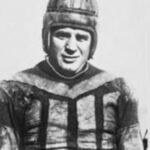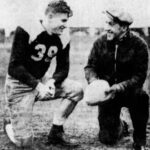There have been many poor-performing teams in NFL history. But the near-impossible question to ask is what is the worst NFL team ever? Some may look to the 2008 Detroit Lions as a prime example of the worst team in NFL history. This is an obvious comparison because the team was the first to go 0 and 16.
Sure, the Cleveland Browns followed that up in 2017 with a “see what I can do, moment.” Is it possible there was a team worse than these teams with a combined 0-32 record? Some argue the combined team of Chicago Cardinals and Pittsburgh Steelers in 1944 was the worst NFL team ever. This week’s episode of When Football Was Football gives a little history into the story. See the full blog post below.
1944 Card-Pitts
With WWII depleting the roster resources of the NFL in 1943, the league was forced to consider drastic measures in order to field a full schedule during the war.
Eventually nearly 1,000 players, coaches, and other personnel from the league served in WWII, with 21 of that number paying the ultimate price. Back in Chicago with both teams struggling to maintain competitive rosters, the Bears and the Cardinals agreed to merge for the 1943 season. However, that proposal was rejected at the NFL meetings in June of that year. As the Associated Press reported:
Apparently because of the power that would be concentrated should the Cardinals and the Bears consolidate, the league cut off their attempt by passing a rule forbidding the merger of player talent. Later, however, this was relaxed, allowing the Steelers and Eagles to pool their athletes but at the same time retain only a single vote in league affairs. The merger will be effective only for the 1943 season.
While the NFL’s decision made little or no sense, both Chicago teams moved ahead independently. Operating on their own in 1943, the talent-challenged Cardinals stumbled through an 0-10 campaign, while the Steelers-Eagles combination (called the Steagles), finished strong with a 5-4-1 mark. Meanwhile, the Bears captured the NFL championship for the season. Only the Cardinals, it seems, suffered because of the NFL’s decision.
Little had changed prior to the 1944 season with Pittsburgh now seeking another partner after the Eagles regained their own independence. And so, this time, the cellar-dwelling Cardinals were asked to merge with the Steelers where the two clubs would share players, home games, and head coaches. It was an ugly marriage that was destined to falter despite some early fears by future opponents. Turk Edwards, the line coach of the Redskins, swiftly anointed the “new” team as the favorite to win the Western Division by stating: “The war has been a great equalizer among pro teams and any two teams which merge, no matter what their standing the preceding year, have a tremendous advantage.
Edwards was wrong.
In Chicago, the Daily News watched the first few days of training camp in Waukesha, WI and proclaimed that “it looks as if the new combine will have a strong voice in the NFL competition this fall. This bit of prophecy is gathered from a glance at the roster of veterans which the two clubs can throw on the field right now.”
The Chicago Daily News was wrong.
The optimism on all sides evaporated quickly as the Card-Pitts dropped their first three league contests, culminating in a 34-7 defeat at the hands of the Chicago Bears on October 15th. Desperate for players, the Cardinals called lineman Vince Banonis (who was in the military) back for the game against the Bears. For Banonis, it turned out to be both a harrowing and tiring weekend:
The Card-Pitt team was something else. I remember the Cardinals calling me to play against the Bears in Chicago. The only problem was that I was in Wildwood, NJ. Although I wasn’t in football shape, I finally did agree to play and hitchhiked to Philadelphia Saturday morning and then took a train to New York. From there the team arranged for a flight to Chicago but it was hard to get a seat in those days and I couldn’t get a plane out of New York until midnight! We puddle-jumped across the country and didn’t arrive in Chicago until 5:00 Sunday morning. I slept a couple of hours, went to Mass and then went to the field. Although I didn’t know the plays I told myself that I wasn’t there to play much. When the other center went out, I played almost the whole game, which was tough being out of shape. After the game, I took a plane back to New York, then took a train to Philadelphia and managed to be back on the base and ready for work at 8:00 am on Monday morning. After that, someone found out and blew the whistle on me…we weren’t supposed to play pro football while we were in the service!
And then, perhaps not surprisingly, things got worse during the remainder of the schedule as the combined squad finished 0-10, including a final game 49-7 drubbing at the hands of the Chicago Bears. “We were terrible,” said Cardinals’ veteran tackle Chet Bulger. “You’d get beat so bad, you’d cry.” Bert Bell, the co-owner of the Steelers, observed quite honestly that “the season couldn’t have turned out any worse than this one.” With each weekly loss, the club earned the derision of both fans and the media alike.
Aside from the mounting losses on the field, the Card-Pitts experienced some very strange locker room events (mostly on the Chicago side) that obviously impacted the team’s performance on the field. Following that 34-7 loss to the Bears, Johnny Butler, Johnny Grigas, and tackle Eberle Schultz were fined $200 each for indifferent play as well as for missing practice. Butler, the seventh-leading rusher in the league in 1943, was also suspended and offered for trade. These rulings infuriated the players, and the team decided to go on strike immediately, recalled tackle Chet Bulger:
Johnny Butler was accused of not trying and was fined a whole game’s salary. So instead of showing up for practice, we’d go to a bar instead. We did that Monday, then Tuesday, then Wednesday… We did this all week and finally Art Rooney called us all into a meeting and told us that Johnny would get his check. He told us to be ready to practice on Friday. So what do we do? We all get to practice early and hide like a bunch of kids from the coaches so they’d think we wouldn’t be there. We played terrible on Sunday!
Following that game, a 23-0 loss to the Giants in front of 40,734, the name of the team was beginning to shred as well. The Card-Pitts label was evolving into Car-Pits, because the team was “in the pits.” Perhaps the Chicago Tribune was in the forefront of this movement when it described the Giants’ game thusly: “The Card-Pitts played the role of a red plush rug this afternoon as the undefeated Giants paraded over and past them for a 23-0 triumph.” This culminated in the sarcastic re-naming of the team from the Card-Pitts to the “Carpets.” And why not? Like a patch of carpet on the floor, NFL teams simply walked all over them!
Although the season spiraled into a parade of losses, almost every outing contained something of interest for everyone:
- In a 42-20 loss at Washington, police were called onto the field to stop a near riot when the opposing players encountered some disagreements. Four players were kicked out, including the aptly named “Cactus Face” Duggan and Tony Bova of the Card-Pitts.
- Although the Lions chomped on his team by the tune of 21-7, Johnny Grigas had one of the finest games in team history by rushing for 123 yards and completing 13 of 30 passes for another 177 yards. He was personally responsible for 300 of the club’s 338 yards (big, big numbers in those days).
- The Card-Pitts didn’t play their first home league game in Chicago until November 19. The Tribune didn’t help drum up any business with its honest headline of “Nothing At Stake.” Only 3,500 showed up to watch the Rams coast to a 33-6 victory.
- Before the final game against the Bears in Pittsburgh (a “home game” for the Card-Pitts and a 49-7 loss), Grigas mysteriously disappeared from the team. His roommate, Don Currivan, said he discovered a note in their room from Grigas which simply stated: “This is the end.” Grigas finished second in the league in rushing despite missing the last game. Two teammates insisted that Grigas had indicated that he would not play if the field was frozen. By game time, the field was partly covered by snow. With Grigas gone, the Cardinals finished with minus-two yards rushing as a team.
Following the Bears game, the Steelers and Cardinals broke off their engagement and never dated again. The Cardinals’ losing streak had now stretched to twenty-six games over three seasons with no end in sight…
In a final “tribute” (so to speak) of the Card-Pitts, the NFL record books rightfully indicate that the league’s longest losing streak is 26 games, enjoyed by Tampa Bay during the 1976 and 1977 campaigns…
However, the Cardinals once dropped 29 games in succession from 1942-1945, but “lost” the honor of claiming the all-time mark since the 1944 team was comprised of both Cardinals and Pittsburgh players during the war. The dubious streak began when the 1942 season was capped by six straight losses. The team then lost all ten league games in both 1943 and 1944 to run the losing streak to 26 games. Three more defeats opened up the 1945 schedule before the Cards began receiving an influx of military veterans who had been serving in the war effort. Chief among the early returnees was 27-year-old rookie quarterback Paul Christman, a second-round draft pick of the Cards in 1941. Christman was sorely needed by the Cardinals and was urged by the team “to fly home before the ink was dry on the discharge.” Christman later recalled that “I got as far as Salt Lake City before an army major bumped me. I reached Chicago four days later by train!”
The rusty Christman still managed to lead the Cardinals past the Bears 16-7 on October 14, 1945 to snap the ugly losing streak at 29. As the Chicago Tribune noted: “A speedy group of backfield performers humbled the once mighty Bears. The victory was the first for the Cardinals in 30 National Football League games.”
So how does history remember the 1944 Card-Pitts? There is not much to say about an 0-10 team, but perhaps Art Rooney, the founder of the Pittsburgh Steelers, said it best: “It was the worst team in NFL history.”
As we say good-by to the legendary Card-Pitts, please stop by for the next program which will focus on “The Wit and Wisdom of Chet Bulger,” the outstanding Cardinals’ tackle in the 1940s who provided humorous insight into nearly every situation he encountered throughout his long NFL career!
Resources
Please Note – As an Amazon Associate I earn from qualifying purchases
More From When Football Was Football
Paddy Driscoll’s Almost Perfect Season
Back at the beginning of the National Football League in...
Read More120,000 Fans Witness High School Football Game in 1937!!!
Let’s set the stage… It was a warm November afternoon...
Read MoreIn The Beginning: An Interview With Joseph T. Sternaman
And, you may ask, who is Joseph T. Sternaman? Sternaman...
Read More1948: The Last Hurrah of the Chicago Cardinals
Cardinals’ fans are familiar with the long, sad story concerning...
Read More



1 thought on “1944 Card-Pitts: The Worst NFL Team Ever?”